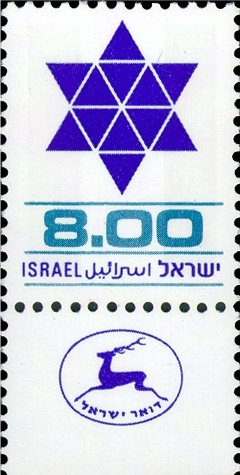Stamp with Collectible Margin: Star of David (Israel 1979)
Star of David (Israel 1979)
22 May (Israel ) within release Star of David Definitives (1975-1980) goes into circulation Stamp with Collectible Margin Star of David face value 8 Israeli lira
| Stamp with Collectible Margin Star of David in catalogues | |
|---|---|
| Michel: | Mi: IL 798T |
| Stamp Number: | Sn: IL 590T |
| Yvert et Tellier: | Yt: IL 740T |
| Stanley Gibbons: | Sg: IL 625T |
Stamp with Collectible Margin is square format.
2 vertical phosphorescent stripsAlso in the issue Star of David Definitives (1975-1980):
- Stamp with Collectible Margin - Star of David face value 1.80;
- Stamp with Collectible Margin - Star of David face value 8;
Stamp with Collectible Margin Star of David it reflects the thematic directions:
A star is a luminous spheroid of plasma held together by self-gravity. The nearest star to Earth is the Sun. Many other stars are visible to the naked eye at night; their immense distances from Earth make them appear as fixed points of light. The most prominent stars have been categorised into constellations and asterisms, and many of the brightest stars have proper names. Astronomers have assembled star catalogues that identify the known stars and provide standardized stellar designations. The observable universe contains an estimated 1022 to 1024 stars. Only about 4,000 of these stars are visible to the naked eye—all within the Milky Way galaxy.
A symbol is a mark, sign, or word that indicates, signifies, or is understood as representing an idea, object, or relationship. Symbols allow people to go beyond what is known or seen by creating linkages between otherwise very different concepts and experiences. All communication (and data processing) is achieved through the use of symbols. Symbols take the form of words, sounds, gestures, ideas, or visual images and are used to convey other ideas and beliefs. For example, a red octagon is a common symbol for "STOP"; on maps, blue lines often represent rivers; and a red rose often symbolizes love and compassion. Numerals are symbols for numbers; letters of an alphabet may be symbols for certain phonemes; and personal names are symbols representing individuals.


